第1章:现代英语词汇学概论【A general servey of English vocabulary】汇总
- 格式:ppt
- 大小:2.64 MB
- 文档页数:63
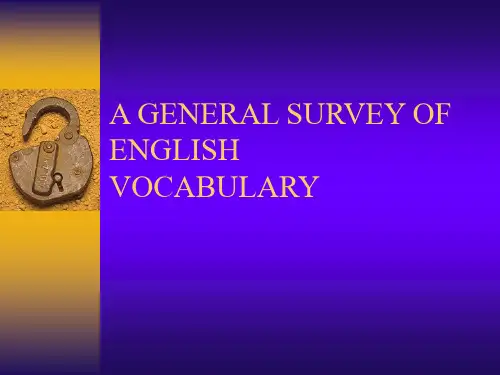
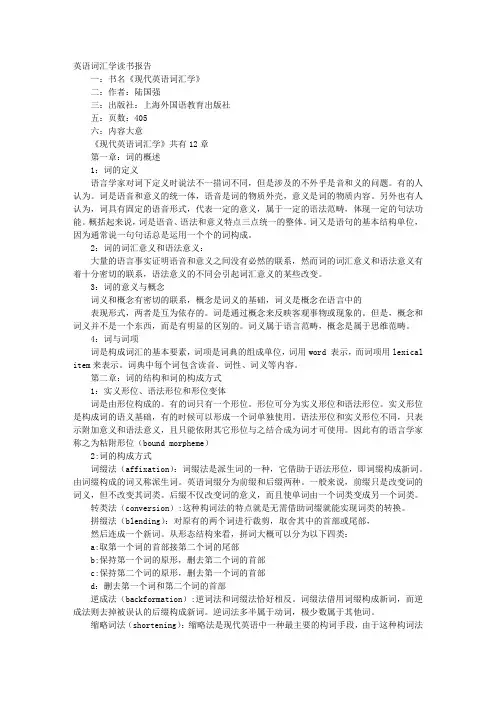
英语词汇学读书报告一:书名《现代英语词汇学》二:作者:陆国强三:出版社:上海外国语教育出版社五:页数:405 六:内容大意《现代英语词汇学》共有12章第一章:词的概述1:词的定义语言学家对词下定义时说法不一措词不同,但是涉及的不外乎是音和义的问题。
有的人认为。
词是语音和意义的统一体,语音是词的物质外壳,意义是词的物质内容。
另外也有人认为,词具有固定的语音形式,代表一定的意义,属于一定的语法范畴,体现一定的句法功能。
概括起来说,词是语音、语法和意义特点三点统一的整体。
词又是语句的基本结构单位,因为通常说一句句话总是运用一个个的词构成。
2:词的词汇意义和语法意义:大量的语言事实证明语音和意义之间没有必然的联系,然而词的词汇意义和语法意义有着十分密切的联系,语法意义的不同会引起词汇意义的某些改变。
3:词的意义与概念词义和概念有密切的联系,概念是词义的基础,词义是概念在语言中的表现形式,两者是互为依存的。
词是通过概念来反映客观事物或现象的。
但是,概念和词义并不是一个东西,而是有明显的区别的。
词义属于语言范畴,概念是属于思维范畴。
4:词与词项词是构成词汇的基本要素,词项是词典的组成单位,词用word 表示,而词项用lexical item来表示。
词典中每个词包含读音、词性、词义等内容。
第二章:词的结构和词的构成方式1:实义形位、语法形位和形位变体词是由形位构成的。
有的词只有一个形位。
形位可分为实义形位和语法形位。
实义形位是构成词的语义基础,有的时候可以形成一个词单独使用。
语法形位和实义形位不同,只表示附加意义和语法意义,且只能依附其它形位与之结合成为词才可使用。
因此有的语言学家称之为粘附形位(bound morpheme)2:词的构成方式词缀法(affixation):词缀法是派生词的一种,它借助于语法形位,即词缀构成新词。
由词缀构成的词又称派生词。
英语词缀分为前缀和后缀两种。
一般来说,前缀只是改变词的词义,但不改变其词类。
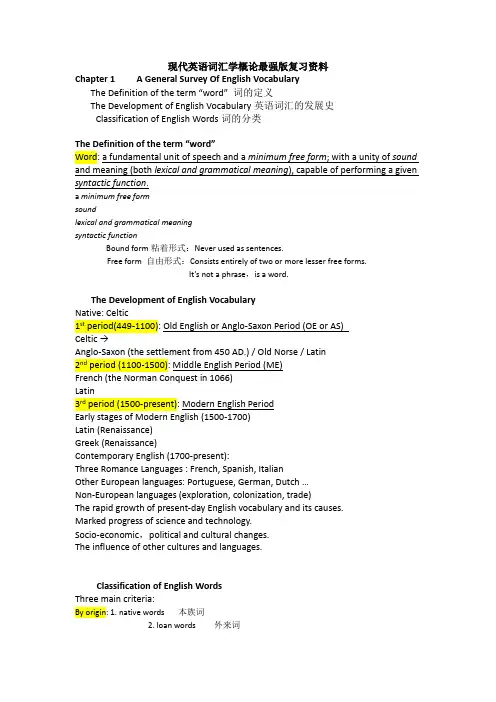
现代英语词汇学概论最强版复习资料Chapter 1 A General Survey Of English VocabularyThe Definition of the term “word” 词的定义The Development of English Vocabulary英语词汇的发展史Classification of English Words词的分类The Definition of the term “word”Word: a fundamental unit of speech and a minimum free form; with a unity of sound and meaning (both lexical and grammatical meaning), capable of performing a given syntactic function.a minimum free formsoundlexical and grammatical meaningsyntactic functionBound form粘着形式:Never used as sentences.Free form 自由形式:Consists entirely of two or more lesser free forms.It’s not a phrase,is a word.The Development of English VocabularyNative: Celtic1st period(449-1100): Old English or Anglo-Saxon Period (OE or AS)Celtic →Anglo-Saxon (the settlement from 450 AD.) / Old Norse / Latin2nd period (1100-1500): Middle English Period (ME)French (the Norman Conquest in 1066)Latin3rd period (1500-present): Modern English PeriodEarly stages of Modern English (1500-1700)Latin (Renaissance)Greek (Renaissance)Contemporary English (1700-present):Three Romance Languages : French, Spanish, ItalianOther European languages: Portuguese, German, Dutch …Non-European languages (exploration, colonization, trade)The rapid growth of present-day English vocabulary and its causes.Marked progress of science and technology.Socio-economic,political and cultural changes.The influence of other cultures and languages.Classification of English WordsThree main criteria:By origin: 1. native words 本族词2. loan words 外来词By level of usage: 1. common words 普通词2. literary words 书面词3. colloquial words 口头词4. slang words 俚语5. technical words 术语By notion: 1. function words 功能词2. content words 实义词By origin:1. native words 本族词2. loan words 外来词Native words: words of Anglo-Saxon origin or of old EnglishFeatures of native words:Most are monosyllabicforming the great majority of the basic word stockLoan / borrowed words: those borrowed from other languagesBasic word stock:auxiliary, modal verbs, numerals, pronouns, prepositions, conjunctions, the most frequently used words (essential to life)National characterStabilityWord-forming abilityAbility to form collocationsBy level of usage:1. Common words 普通词2. Literary words 书面词3. Colloquial words 口头词4. Slang words 俚语5. Technical words 术语*There are no clear-cut boundaries between the various classes of words.Common words普通词:connected with the ordinary things or activities necessary to everyday lifeThe core of the common words is the basic word stock.Stylistically neutralLiterary words书面词:chiefly used in writing, especially in books written in a more elevated style, in official documents, or in formal speeches.Most are of French, Latin or Greek origin.Among the literary word, two categories are noteworthy:archaic words . obsolete words)poetical wordsSlang俚语:Language, words or phrases of a vigorous, colorful, facetious, or taboo nature, invented for specific occasions, or uses or derived from the unconventional use of the standard vocabularyNot generally used in informal conversation unless the speakers are on intimate termsEmbracing those daring and new expression that have not been accepted as standard EnglishThe chief reason for use of slang: secure freshness and noveltyTechnical words术语:used in various fields: science, profession or trade, art, sportincreasing precision in nomenclatureone specific meaningLatin or Greek in originBy notion:1. function words 功能词2. content words 实义词Function words:determiners, conjunctions, prepositions, auxiliariesnot having much lexical meaningserving grammatically:Behaving like grammatical signals or functional markers,Expressing the kinds of connection between content wordsConstructing acceptable English sentencessmall in number and stable:In relatively closed listsBelonging to a relatively small and permanent set of words)high frequency。

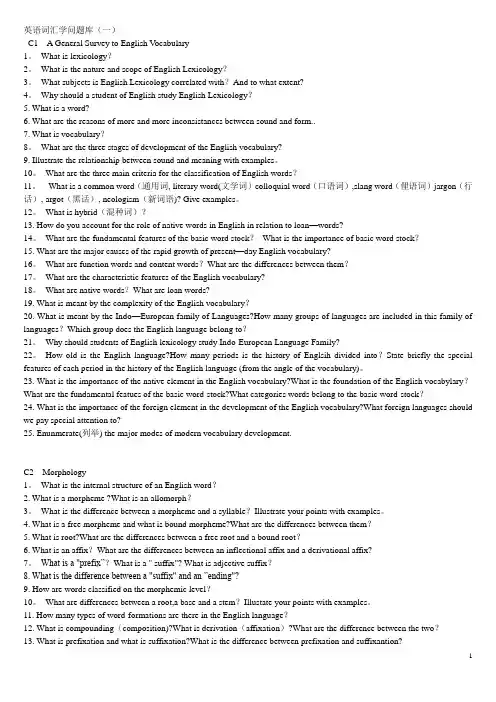
英语词汇学问题库(一)C1 A General Survey to English V ocabulary1。
What is lexicology?2。
What is the nature and scope of English Lexicology?3。
What subjects is English Lexicology correlated with?And to what extent?4。
Why should a student of English study English Lexicology?5. What is a word?6. What are the reasons of more and more inconsistances between sound and form..7. What is vocabulary?8。
What are the three stages of development of the English vocabulary?9. Illustrate the relationship between sound and meaning with examples。
10。
What are the three main criteria for the classification of English words?11。
What is a common word(通用词, literary word(文学词)colloquial word(口语词),slang word(俚语词)jargon(行话), argot(黑话), neologism(新词语)? Give examples。
12。
What is hybrid(混种词)?13. How do you account for the role of native words in English in relation to loan—words?14。

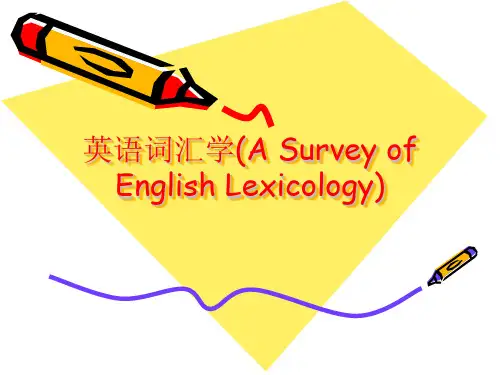
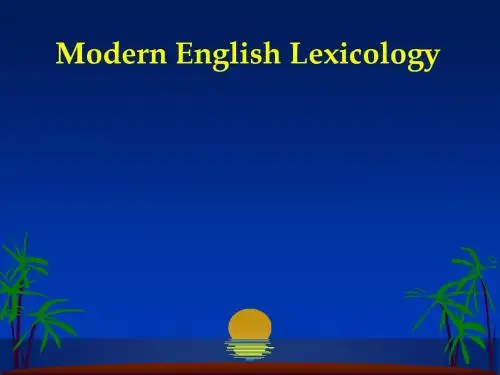
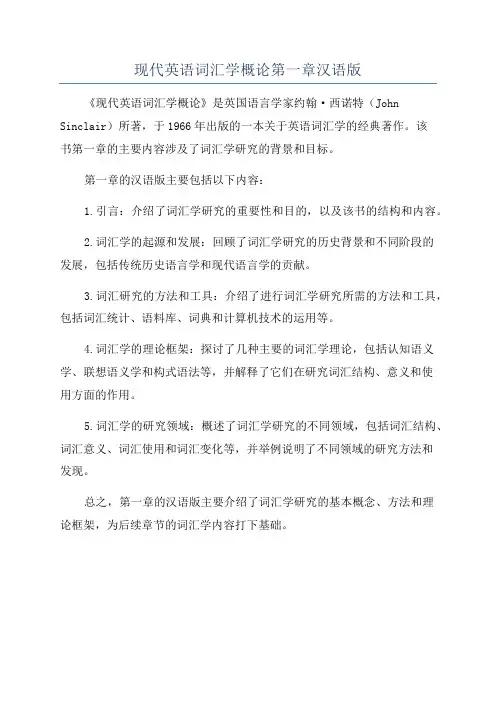
现代英语词汇学概论第一章汉语版
《现代英语词汇学概论》是英国语言学家约翰·西诺特(John Sinclair)所著,于1966年出版的一本关于英语词汇学的经典著作。
该
书第一章的主要内容涉及了词汇学研究的背景和目标。
第一章的汉语版主要包括以下内容:
1.引言:介绍了词汇学研究的重要性和目的,以及该书的结构和内容。
2.词汇学的起源和发展:回顾了词汇学研究的历史背景和不同阶段的
发展,包括传统历史语言学和现代语言学的贡献。
3.词汇研究的方法和工具:介绍了进行词汇学研究所需的方法和工具,包括词汇统计、语料库、词典和计算机技术的运用等。
4.词汇学的理论框架:探讨了几种主要的词汇学理论,包括认知语义学、联想语义学和构式语法等,并解释了它们在研究词汇结构、意义和使
用方面的作用。
5.词汇学的研究领域:概述了词汇学研究的不同领域,包括词汇结构、词汇意义、词汇使用和词汇变化等,并举例说明了不同领域的研究方法和
发现。
总之,第一章的汉语版主要介绍了词汇学研究的基本概念、方法和理
论框架,为后续章节的词汇学内容打下基础。
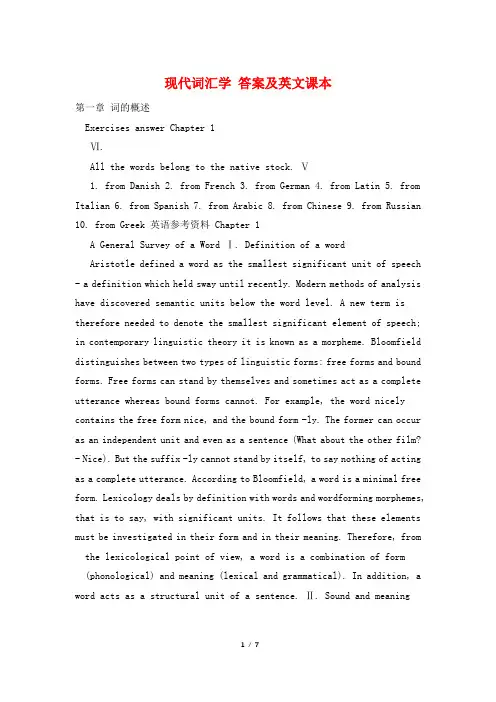
现代词汇学答案及英文课本第一章词的概述Exercises answer Chapter 1Ⅵ.All the words belong to the native stock. Ⅴ1. from Danish2. from French3. from German4. from Latin5. from Italian6. from Spanish7. from Arabic8. from Chinese9. from Russian10. from Greek 英语参考资料 Chapter 1A General Survey of a Word Ⅰ. Definition of a wordAristotle defined a word as the smallest significant unit of speech - a definition which held sway until recently. Modern methods of analysis have discovered semantic units below the word level. A new term is therefore needed to denote the smallest significant element of speech; in contemporary linguistic theory it is known as a morpheme. Bloomfield distinguishes between two types of linguistic forms: free forms and bound forms. Free forms can stand by themselves and sometimes act as a complete utterance whereas bound forms cannot. For example, the word nicely contains the free form nice, and the bound form -ly. The former can occur as an independent unit and even as a sentence (What about the other film? - Nice). But the suffix -ly cannot stand by itself, to say nothing of acting as a complete utterance. According to Bloomfield, a word is a minimal free form. Lexicology deals by definition with words and wordforming morphemes, that is to say, with significant units. It follows that these elements must be investigated in their form and in their meaning. Therefore, from the lexicological point of view, a word is a combination of form(phonological) and meaning (lexical and grammatical). In addition, a word acts as a structural unit of a sentence. Ⅱ. Sound and meaningThe Naturalists have argued that the origin of language lies in onomatopoeia, that people began talking by creating iconic signs to imitate the sounds heard around them in nature. They maintain that there is a natural connection between sound and meaning. The Conventionalists, on the other hand, hold that the relations between sound and meaning are conventional and arbitrary. Facts have proved this argument to be valid. Words that convey the same meaning have different phonological forms in different languages - for example, English meat / mi:t /,Chinese ròu. Alternatively, the same phonological forms may convey different meanings - for example, sight, site, cite. Ⅲ. Meaning and conceptMeaning is closely related to a concept. A concept is the base of the meaning of a word. A word is used to label a concept. It acts as the symbol for that concept. The concept is abstracted from the person, thing, relationship, idea, event, and so on, that we are thinking about. We call this the referent. The word labels the concept, which is abstracted from the referent; the word denotes the referent, but does not label it. This approach to meaning can be diagrammed as follows: word - concept - referent The formula shows that the word refers to the referent through a concept.A concept is an abstraction from things of the same kind.When someone says \to you, how do you know it is a chair? It is simply because it shows certain characteristics shared by all the objects you call chairs. You have abstracted these characteristics from your experience of chairs, and from what you have learned about chairs. From this it can be deduced that a concept refers to something in general, but not something in particular. A word, however, can refer to both, as is shown in the following two sentences:...some have begun to realize that the automobile is a mixed blessing. The automobile was stalled in a snowstorm.The word \general whereas the word in the second sentence refers to a specific one. There are two aspects to the meaning of a word: denotation and connotation. The process by which the word refers to the referent is called \For example, the denotation of \is \quadruped\The denotative meaning of a word usually refers to the dictionarydefinition of a word. As opposed to denotation, connotation refers to the emotional aspect of a word. For example, the connotation of \include \ Ⅳ. Lexical item and vocabularyA unit of vocabulary is generally referred to as a lexical item. A complete inventory of the lexical items of a language constitutes that language's dictionary. In New Horizons in Linguistics, John Lyons points out that \ The term vocabulary usually refers to a complete inventory of the words in a language. But it may also refer to the words and phrases used in the variants of a language, such as dialect, register, terminology, etc. The vocabulary can be divided into active vocabulary and passive vocabulary: the former refers to lexical items which a person uses; the latter to words which he understands.The English vocabulary is characterized by a mixture of native words and borrowed words. Most of the native words are of Anglo-Saxon origin. They form the basic word stock of the English language. In the native stock we find words denoting the commonest things necessary for life, natural phenomena, divisions of the year, parts of the body, animals, foodstuffs, trees, fruits, human activity and other words denoting the mostindispensable things. The native stock also includes auxiliary and modal verbs, pronouns, most numerals, prepositions and conjunctions. Though small in number, these words play no small part in linguistic performance and communication.Borrowed words, usually known as loan-words, refer to linguistic forms taken over by one language or dialect from another.The English vocabulary has replenished itself by continually taking over words from other languages over the centuries. The adoption of foreign words into the English language began even before the English came to England. The Germanic people, of which the Angles and Saxons formed a part, had long before this event been in contact with the civilization of Rome. Words of Latin origin denoting objects belonging to that civilization (wine, butter, cheese, inch, mile, mint, etc.) gradually found their way into the English language.When the English were settled in England, they continued to borrow words from Latin, especially after Roman Christianity was introduced into the island in the sixth and seventh centuries. A considerable number of Latin words, chiefly signifying things connected with religion or the services of the church, were adopted into the English language. Among those which are still part of the language are bishop, candle, creed, font, mass, monk, priest and a great many others.To the Danes and Northmen the English vocabulary also owes a great deal. From these settlers, English adopted a surprising number of words of Scandinavian origin that belong to the core-vocabulary today: they (them, their), both, ill, die, egg, knife, low, skill, take, till, though, want, etc.The Norman Conquest in 1066 introduced a large number of French words into the English vocabulary. French adoptions were found in almost every section of the vocabulary: law (justice, evidence, pardon...), warfare (conquer, victory, archer...), religion (grace, repent, sacrifice...), architecture (castle, pillar, tower...), finance (pay, rent, ransom...), rank (baron, master, prince...), clothing (collar, mantle, vestment...), food (dinner, feast, sauce...) and many others. As an indication of the tremendous influx of French words, we may note that, discounting propernames, there are 39 words of French origin in the first 43 lines of the Prologue to Chaucer's Canterbury Tales.The revival of art and literature based on ancient Greek learning, known as the Renaissance in the 14th, 15th and 16th centuries, opened up a new source from which the English vocabulary could be enriched. English has borrowed many words from Greek through the medium of Latin and a smaller number direct, such as rhapsody, crisis, topic, pathos, stigma, coma, tonic, cosmos, dogma. From Greek also comes a wide range of learned affixes, such as bio-, chrono-, geo-, hydro-, logo-, auto-, hemi-, hetero-, homo-, mono-, neo-, epi-, meta-, para-, -ism, -ise, -logy, -graph, -phile, -meter, -gram and many others.From the sixteenth century onward, there was a great increase in the number of languages from which English adopted words. French continued to provide a considerable number of new words, for example, trophy, vase, moustache, unique, attic, soup. The Italian element was particularly strong in the fields of art, music and literature, for example, model, sonnet, opera, vista, soprano, quartet. There was also a Spanish element in English, for example, sherry, potato, cargo, parade, cigar. German, Portuguese and Dutch were also fertile sources of loan words, for example, dock, carouse, plunder, zinc, quarts (German); flamingo, cobra, caste, buffallo, pagoda (Portuguses); booze, wainscot, tackle, buoy, skipper, dock (Dutch).At the turn of the 19th and 20th centuries, with a growth ofinternational trade and the urge to colonize and dominate the unknown world, English made a number of direct adoptions from languages spoken outside Europe. Some examples are: sultan, sheikh, ghoul, roc (Arabic); boomerang, billabong, wombat, dingo (Australian); lichi, sampan, typhoon, ketchup (Chinese); shibboleth, kibbutz (Hebrew); schmozze, schmaltz (Yiddish); shah, divan, shawl, caravan (Persian); caften, yoghourt, kiosk,bosh (Turkish); bwana, safari (Swahili); hara-kiri. tycoon, kamikaze, judo (Japanese); guru, pundit, swami, pukka (Hindustani); proa, amok, raffia, sarong (Indonesian); rouble, czar, troika, commissar (Russian). Since the end of the Second World War, still more loanwords have been incorporated into the English vocabulary, for example, haute cuisine, discotheque, engagé (French), sushi (Japanese); gulag, apparatchik (Russian); mao tai (Chinese); favela (Portuguese); autostrada (Italian); autopista (Spanish); hamam (Arabic) and many others.In the present century it should be observed that English has created many words out of Latin and Greek elements, especially in the fields of science and technology, such as aerodyne, ambivert, androgen, antibiotic, astronaut, auto-visual, autolysis, barysphere, cacogenics, callipyous, chromosome, cartology, cryotron, cyclorama, dendrochronology,dromophobia, hypnotherapy, hypothermia, isotope... Because the lexical sources of Latin and Greek are treated as if they belonged to English, many neologisms combine elements from different sources: aqualung, television, microgroove, sonobuoy, etc. Although all these Latin-and Greek-derived words are distinctly learned or technical, they do not seem foreign, and are very different in this respect from the recent loanwords from living languages, such as montage, angst, cappuccino, sputnik, etc. Thus, for the Modern English period a distinction must be made between the adoptions from living languages and the formations derived from the two classical languages.第二章词的结构和词的构成方式练习答案Chapter 2Ⅲ:astir = in motion; in excited activity awhir = whirringanti-Marketeer = an opponent of Great Britain's entry into the European Common Marketanti-theatre = the theatre that lacks most of the traditional features of the theatredeplane = get out of an airplane after it landsdenationalize = deprive...of national rights or status disambiguate = rid...of ambiguity disadapt = make...unable to adaptecocide = the destruction of the earth's ecology through the uncontrolled use of pollutantsecocatastrophe = a catastrophe (a large-scale disaster) resulting from the uncontrolled use of pollutants。
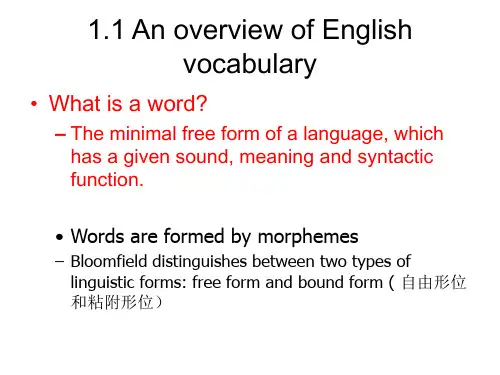
Chapter OneA general survey of vocabularyI.Definition of word:“A free form which is not a phrase, is a word. A word , then, is a free form which does not consist entirely of (two or more) lesser free forms; in brief, a word is a minimum free form.”---Bloomfield,1933:177-178“A word is defined by the association of a given sense with a given group of sounds capable of a given grammatical use.”---French linguist, Antonine Meillet Q: Any disadvantages in the above definitions?A word may be defined as a fundamental unit of speech and a minimum free form; with a unity of sound and meaning (both lexical and grammatical meaning), capable of performing a given syntactic function.---Zhang Yun-fei, An Introduction to Modern English Lexicology, 1990, P2“词,今指语言组织中的基础单位,能独立运用,具有声音、意义和语法功能。
”---《辞海》上海辞书出版社1984 (上)375页“词是代表一定意义、具有固定的语音形式、可以独立运用的最小结构单位。
张韵斐著《现代英语词汇学概论》——解析第一部分Chapter Ⅰ英语词汇的概论(A general survey of English vocabulary)Bloomfield 1933 中对词的定义是,每个单词都是最小的自由词。
然而这个定义不够全面,存在着缺陷。
首先,不是所有的单词都可以独立出现,如the ,a ,my 这些单词单独出现则没有具体意义。
另外,Bloomfield的定义侧重在于语法(syntax)却没有涉及到词的意义。
随着词汇学的发展跟完善,人们给词下了较为完整的定义。
“词,今指语言组织中的基础单位,能独立运用,具有声音、意义和语法功能。
”(《辞海》1984(上)375页,上海辞书出版社)一种语言中所有的单词汇集起来便构成了该语言的词库。
纵观英语的发展历史,我们可以知道,大多数的英语词汇都是外来词,它从拉丁语,法语和希腊语等语言中汲取词汇,不断的扩充自己,为己所用。
特别是第二次世界大战之后,英语词汇得到了空前的发展。
现代英语词汇快速发展的原因主要有四方面。
一是科学技术的快速发展,二是社会经济的全球化,三是英语国家的政治和文化变化,最后是其他文化和语言对英语的强烈影响。
英语词汇是由各种不同类型的单词组成,而这些单词有着不同的分类标准。
根据词的起源可以分为本族语和外来语;根据使用水平可以分为普通词汇,文学词汇。
口头词汇,俚语以及科学术语。
基础语库的基本特征是具有民族特征,稳定性,构词的能力和搭配能力。
第二部分Chapter Ⅱ到Chapter Ⅳ英语词汇的形态结构和词的构词(Morphological structure of English words and word-formation )(一)词素(Morphemes)单词是有词素(morphemes)构成的。
词素即英语语言中有意义的最小单位,同时具有声音和意义。
单词可以有一个或一个以上的词素组成。
如:nation 是一个词素,national有nation+al 两个词素。